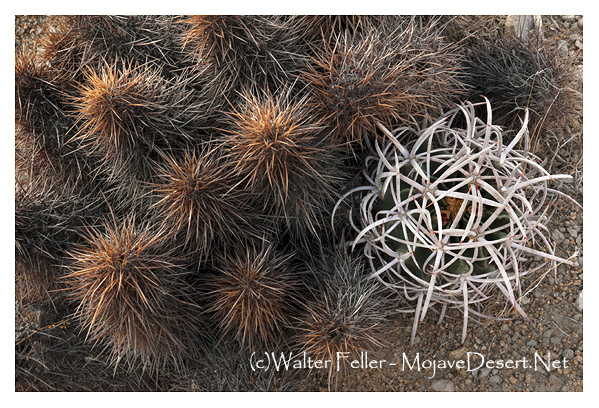Mojave Desert Cactus

Cacti occur in a wide range of shapes and sizes, a thick, fleshy plant that grows in many hot, dry habitats subject to drought such as deserts.
Cactus are members of the family Cactaceae and can live in extremely dry environments as they have made adaptations to conserve water. Almost all cacti are succulents, they have thickened, fleshy parts adapted to storing water. Most species have lost true leaves, leaving spines, which are highly modified leaves. Spines help prevent water loss by reducing air flow, providing shade and defense against herbivores.
Cactus in the Mojave Desert
The Mojave Desert, located primarily in southern California and Nevada, is known for its extreme aridity and harsh conditions. Despite the challenging environment, several species of cactus thrive in this desert region, showcasing their unique adaptations and adding to the desert's beauty.To the newcomer, one of the most iconic cacti found in the Mojave Desert is not a cactus. It is the Joshua tree (Yucca brevifolia). Though it appears as if it may be a cactus, it is not. It is often associated with the desert landscape. The Joshua Tree symbolizes the Mojave Desert and can be seen scattered across the arid terrain with its distinctive twisted branches and spikey leaves.
A noteworthy cactus in the Mojave Desert is the Mojave Mound Cactus (Echinocereus triglochidiatus). This species is known for its vibrant red and orange flowers that bloom in the spring, contrasting with the otherwise barren landscape. The Mojave Mound Cactus is well adapted to the desert's harsh conditions, with its ability to store water in its fleshy stems and spines that help reduce water loss through transpiration.
The Beavertail Cactus (Opuntia basilaris) is common in the Mojave Desert. It gets its name from its flat, round pads that resemble a beaver's tail. This cactus produces beautiful pink or purple flowers that bloom in the spring. The Beavertail Cactus is also known for its edible fruit, which has a sweet flavor and is a source of nourishment for desert wildlife.
One of the most unique cacti found in the Mojave Desert is the Barrel Cactus (Ferocactus cylindraceus). As its name suggests, this cactus has a barrel-like shape with thick, ribbed stems. It has adapted to the desert's harsh conditions by developing a waxy coating on its skin to minimize water loss. The Barrel Cactus also has long, sharp spines that serve as a defense mechanism against herbivores.
Cacti in the Mojave Desert plays a crucial role in the ecosystem. They provide shelter and food for a variety of desert animals, including birds, insects, and small mammals. Some cacti even act as nurse plants, providing shade and protection for other desert plants to grow.
The survival of cacti in the Mojave Desert is a testament to their remarkable adaptability. Their ability to conserve water, withstand extreme temperatures, and protect themselves from herbivores allows them to thrive in this harsh environment. These resilient plants serve as a reminder of nature's ability to persevere and adapt in even the most challenging conditions.
In conclusion, cacti in the Mojave Desert are visually striking and essential components of the desert ecosystem. Their unique adaptations and ability to survive in extreme conditions make them integral to the desert. So, the next time you wander through the Mojave Desert, appreciate these fascinating cacti's resilience and beauty.
Foxtail cactus
Teddybear cholla
Silver cholla
Pencil cholla
Cottontop cactus
Hedgehog cactus
Mojave mound cactus
California barrel cactus
Beavertail pricklypear
Grizzlybear pricklypear
also see: